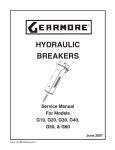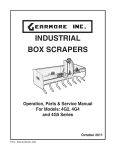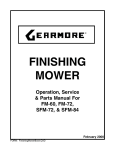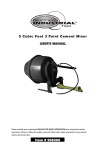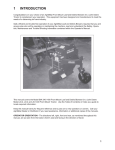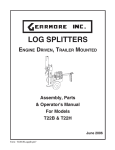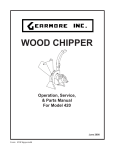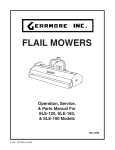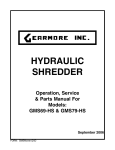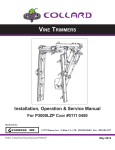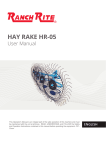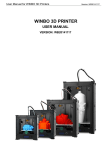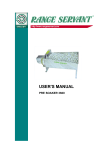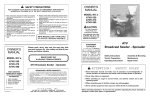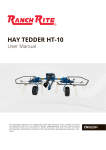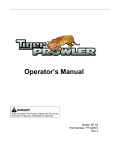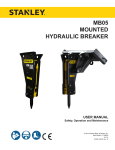Download HYDRAULIC BREAKER
Transcript
HYDRAULIC BREAKER Operator's Manual For Models: G10, G20, G30, G40, G50, G60, & G100 June 2007 Form: HydBreaker.pm7 TABLE OF CONTENTS SECTION DESCRIPTION PAGE 1 2 3 4 5 6 1.1 Introduction .............................................................. 1 Serial Number Location .......................................... 1 2.1 2.2 2.3 2.4 2.5 Safety............................................................................ 2 General Safety ......................................................... 3 Important Safety Guidelines................................... 4 Safety Training ........................................................ 5 Safety Signs ............................................................. 5 Hydraulic Safety ...................................................... 5 3.1 3.2 3.3 Specifications ............................................................. 6 Recommended Machine Weights ............................ 6 Breaker Specifications ............................................. 6 Available Tools ......................................................... 7 4.1 4.2 Installation ................................................................. 7 Hydraulic Installation ............................................. 7 Mechanical Installation ........................................... 7 5.1 5.2 5.3 5.4 5.5 5.6 Operation .................................................................... 8 Instructions for Use ................................................. 8 Initial Operation ...................................................... 9 Operating Hydraulic Breaker ................................. 9 Points to Note...................................................... 9-10 Removal and Mounting of Breaker ....................... 10 Changing Breaker Tool ......................................... 11 6.1 6.2 6.3 6.4 6.5 Maintenance ............................................................. 12 Daily Inspection ..................................................... 12 Maximum Clearance ............................................. 12 Gas Charging Kit ................................................... 13 Checking Gas Pressure ......................................... 13 Maximum Nitrogen GAs Pressures ...................... 14 7 Troubleshooting ...................................................... 15 8 Limited Warranty .................................................... 16 1 INTRODUCTION Gearmore is the leading supplier of hydraulic breaker attachments for Skid-Steer Loaders, backhoe, and mini-excavators. You can have confidence in the quality and durability of any of our hydraulic breakers. Gearmore hydraulic breakers employ a unique cylinder design to provide a light, yet strong breaker which are easily serviceable and require very little routine maintenance. This comprehensive operators manual provides full instruction on the safe and productive use of our hydraulic breakers. Operators should read and understand all aspects of this manual to get the best service from your hydraulic breaker. 1.1 SERIAL NUMBER LOCATION Always give your dealer the serial number of your hydraulic breaker when ordering parts or requesting service or other information. The serial number plate is located where indicated. Please mark the number in the space provided for easy reference. serial number plate DATE OF PURCHASE: ___________________________ MODEL NUMBER: ______________________________ SERIAL NUMBER: ______________________________ 1 2 SAFETY SAFETY ALERT SYMBOL This Safety Alert symbol means ATTENTION! BECOME ALERT! YOUR SAFETY IS INVOLVED! The Safety Alert symbol identifies important safety messages on the Tandem Discs and in the manual. When you see this symbol, be alert to the possibility of personal injury or death. Follow the instructions in the safety message. Why is SAFETY important to you? 3 Big Reasons SIGNAL WORDS: Note the use of the signal words DANGER, WARNING and CAUTION with the safety messages. The appropriate signal word for each message has been selected using the following guide-lines: SI NO LEE INGLES, PIDA AYUDA A AIGUIEN QUE SI LO LEA PARA QUE LE TRADUZCA LAS MIDIDAS DE SEGURIDAD. Accidents Disable and Kill Accidents Cost Accidents Can Be Avoided DANGER - Indicates an imminently hazardous situation that, if not avoided, will result in death or serious injury. This signal word is to be limited to the most extreme situations typically for machine components which, for functional purposes, cannot be guarded. WARNING - Indicates a potentially hazardous situation that, if not avoided, could result in death or serious injury, and includes hazards that are exposed when guards are removed. It may also be used to alert against unsafe practices. CAUTION - Indicates a potentially hazardous situation that, if not avoided, may result in minor or moderate injury. It may also be used to alert against unsafe practices. If you have any questions not answered in this manual or require additional copies or the manual is damaged, please contact your dealer. 2 2.1 GENERAL SAFETY IMPORTANT SAFETY INFORMATION WHEN USING OUR HYDRAULIC BREAKERS 1. Operators and service personnel must read and thoroughly understand this operators manual before using your breaker. 2. Keep all people clear of breaker while in operation. 3. Do not operate the breaker without checking that all of the applicable safety equipment/shielding is on the operating machine and working correctly. FAILURE TO COMPLY MAY RESULT IN INJURY OR DEATH. 4. TO PREVENT INJURY OR DEATH, do not disassemble a breaker before discharging the nitrogen gas precharge. 5. Do not hardface or sharpen a tool with a cutting torch. Excessive heat from torching or welding causes embrittlement, breakage, and flying pieces. Resharpen only with a lathe or milling machine using sufficient cooling. 6. Fully extend tool while charging the breaker with nitrogen. STAY CLEAR OF TOOL WHILE CHARGING. 7. For precharging the hydraulic breaker use nitrogen gas only. 8. Do not operate the breaker unless the operator is in full control of the machine. Operate the breaker from the operators seat only. 9. Important safety decals are provided with each breaker. Keep them clean and visible. Gearmore will provide decals free of charge as needed. 10. It is very important to have compatibility between the breaker and the machine. Please refer to the Recommended Machine Weight section of this manual. 11. Use the proper lifting equipment and tools when handling or servicing the breaker or any of it's components. 12. Wear ear protection if conditions warrant. 13. Service personnel must take care handling pins and bushings when exchanging the bucket for the breaker. The machine operator must move the arm or boom only when directed by service personnel. 14. If it is necessary to hammer the pins in or out, beware of flying metal chips. Eye protection should be worn. 15. Do not make any alterations to the breaker. Alterations must be made by trained service personnel. 16. Use replacement parts only sold by Gearmore. 17. Have a first-aid kit available for use should the need arise use it. and know how to 18. Have a fire extinguisher available for use should the need arise and know how to use it. 3 2.2 IMPORTANT SAFETY GUIDELINES Safety of the operator and bystanders is one of the main concerns in designing and developing a machine. However, every year many accidents occur which could have been avoided by a few seconds of thought and a more careful approach to handling equipment. You, the operator, can avoid many accidents by observing the following precautions in this section. To avoid personal injury or death, study the following precautions and insist those working with you, or for you, follow them. • Avoid blank hammering. • DO NOT hammer in the same tool position for over thirty (30) seconds. • DO NOT use the breaker to move material, pry material or any other use that it is not designed for. • DO NOT submerge the breaker under water unless the breaker has been modified for underwater operation. • Replace any safety sign or instruction sign that is not readable or is missing. • • NEVER use alcoholic beverages or drugs which can hinder alertness or coordination while operating this equipment. Consult your doctor about operating this machine while taking prescription medications. Prevent contaminiation from entering the hydraulic hoses when mounting or dismounting the breaker from the machine. • Maintain a clean hydraulic system. • Replace the filter element with a new one and change hydraulic oil at the specified intervals. • Under no circumstances should young children be allowed to work with this equipment. Do not allow persons to operate or assemble this unit until they have read this manual and have developed a thorough understanding of the safety precautions and of how it works. Review the safety instructions with all users annually. • This equipment is dangerous to children and persons unfamiliar with its operation. The operator should be a responsible, properly trained and physically able person familiar with the machine and trained in this equipment's operations. • Perform daily inspections. 4 Filter Element ------- Every 100 hours Hydraulic Oil -------- Every 800 hours • Operate the breaker carefully. DO NOT hit the boom of the machine with the breaker. In addition to the design and configuration of this implement, including Safety Signs and Safety Equipment, hazard control and accident prevention are dependent upon the awareness, concern, prudence and proper training of personnel involved in the operation, transport, maintenance and storage of the machine. Think SAFETY! Work SAFELY! 2.3 SAFETY TRAINING Safety is a primary concern in the design and manufacture of our products. Unfortunately, our efforts to provide safe equipment can be wiped out by a single careless act of an operator or bystander. How To Install Safety Signs: In addition to the design and configuration of equipment, hazard control and accident prevention are dependent upon the awareness, concern, prudence and proper training of personnel involved in the operation, transport, maintenance and storage of this equipment. • • It has been said, "The best safety feature is an informed, careful operator." We ask you to be that kind of an operator. It is the operator's responsibility to read and understand ALL Safety and Operating instructions in the manual and to follow these. Accidents can be avoided. Working with unfamiliar equipment can lead to careless injuries. Read this manual, and the manual for your machine, before assembly or operating, to acquaint yourself with the equipment. If this implement is used by any person other than yourself, or is loaned or rented, it is the machine owner's responsibility to make certain that the operator, prior to operating: a. Reads and understands the operator's manuals. b. Is instructed in safe and proper use. Know your controls and how to stop machine quickly in an emergency. Train all new personnel and review instructions frequently with existing workers. Be certain only a properly trained and physically able person will operate the machinery. A person who has not read and understood all operating and safety instructions is not qualified to operate the machine. An untrained operator exposes himself and bystanders to possible serious injury or death. 2.4 SAFETY SIGNS 1. Keep safety signs clean and legible at all times. 2. Replace safety signs that are missing or have become illegible. 3. Safety signs are available from your authorized dealer or from Gearmore. • • • • • 2.5 Be sure that the installation area is clean and dry. Be sure temperature is above 50º F (10º C). Determine exact position before you remove the backing paper. Remove the smallest portion of the split backing paper. Align the sign over the specified area and carefully press the small portion with the exposed sticky backing in place. Slowly peel back the remaining paper and carefully smooth the remaining portion of the sign in place. Small air pockets can be pierced with a pin and smoothed out using the piece of sign backing paper. HYDRAULIC SAFETY Make sure that all the components in the hydraulic system are kept in good condition and are clean. Replace any worn, cut, abraded, flattened or crimped hoses and metal lines. Relieve pressure before working on hydraulic system. Do not attempt any makeshift repairs to the hydraulic lines, fittings or hoses by using tapes, clamps or cements. The hydraulic system operates under extremely high pressure. Such repairs will fail suddenly and create a hazardous and unsafe condition. Wear proper hand and eye protection when searching for a high pressure hydraulic leak. Use a piece of wood or cardboard as a backstop instead of hands to isolate and identify a leak. If injured by a concentrated high pressure stream of hydraulic fluid, seek medical attention immediately. Serious infection or toxic reaction can develop from hydraulic fluid piercing the skin surface. Before applying pressure to the system, make sure all components are tight and that lines, hoses and couplings are not damaged. When disconnecting hydraulic lines, shut off hydraulic supply and relieve hydraulic pressure. 5 3 SPECIFICATIONS 3.1 RECOMMENDED MACHINE WEIGHTS Machine weight ranges are intended as a guideline only. Other factors, such as arm length, counterweights, undercarriage, etc., must be taken into consideration. MOUNTING A BREAKER THAT IS TOO HEAVY FOR THE MACHINE CAN BE DANGEROUS AND DAMAGING. MOUNTING A BREAKER THAT IS TOO SMALL FOR THE MACHINE CAN DAMAGE THE BREAKER AND VOID THE WARRANTY BREAKER MODEL RECOMMENDED MACHINE WEIGHT RANGE G10 ..................................................1560 to 2250 lbs. G20 ..................................................2250 to 6750 lbs. G30 ..................................................4450 to 8890 lbs. G40 ................................................ 5600 to 11,000 lbs. G50 ................................................ 8200 to 16,800 lbs. G60 ................................................ 9000 to 18,700 lbs. G100 ..............................................18,000 to 24,200 lbs. 3.2 BREAKER SPECIFICATIONS Breaker Model Operating Pressure bar/psi Required Oil Blows Per Flows Minute Lpm/USgpm (bpm) G10 G20 G30 G40 G50 G60 G100 105 / 1525 95 / 1350 110 / 1600 114 / 1650 110 / 1700 128 / 1800 128 / 1800 15-30 / 4-7 20-40 / 5-10 30-50 / 8-13 30-60 / 8-16 45-80 / 12-21 56-61 / 14-26 68-110 / 18-29 650 - 1100 650 - 1150 700 - 1250 550 - 1250 650 - 1400 550 - 1200 550 - 1200 Nitrogen Pressure bar/psi Overall Weight kg/lbs Overall Length mm/inches 20 / 290 23 / 330 23 / 330 20 / 290 20 / 290 25 / 360 22 / 320 75 / 168 100 / 220 135 / 303 230 / 505 255 / 575 330 / 725 490 / 1078 1020 / 42 1170 / 46 1295 / 51 1448 / 57 1525 / 60 1600 / 63 1650 / 65 Please note working weights may vary with bracket/side plate configuration. Specifications subject to change without notice. 6 3.3 TOOLS AVAILABLE FOR THE HYDRAULIC BREAKER TOOL TYPE Conical Point Chisel (Cross cut or In Line) 4 APPLICATION • Concrete breaking • General demolition • Trenching • Breaking oversize • General demolition INSTALLATION 4.1 HYDRAULIC INSTALLATION OF THE BREAKER All hydraulic breakers can be adapted to use most hydraulic boom fittings and tubing found on backhoes / excavators that are used for demolition breaking. Contact your nearest dealer for information on how to adapt your currently fitted hydraulic kit. Special hydraulic pressure regulators are not required as our hydraulic breaker operating pressure is self regulating. 4.2 MECHANICAL INSTALLATION OF THE BREAKER The parts required for the mechanical adaptation of the hydraulic breaker to the machine boom are provided as standard with every hydraulic breaker. There are various choices for mounting options. Please contact your nearest dealer for these mounting kit options. 7 5 OPERATION 5.1 INSTRUCTIONS FOR USING THE HYDRAULIC BREAKER BEFORE STARTING THE BREAKER: • CHECK THE NITROGEN GAS PRESSURE The nitrogen gas precharge is factory checked before you receive your breaker, but it is recommended the pressure be checked before using the breaker for the first time. Please refer to the relevant section of this manual to understand how to check the gas pressure. • PRE-OPERATION INSPECTION AND WARM UP Before operating any of our hydraulic breakers, be sure to perform these routine inspection procedures. Please carry out the following inspection before use: • Check for any signs of visual damage to the breaker. Early detection of any problems can prevent further potentially serious damage to the breaker or the machine. • Lubricate the tool and tool bushing. To ensure that no damage occurs, caused by seizing, to the tool or tool bushing by greasing the working parts every 2 - 3 hours. Introduce grease, via a grease gun, through the fitting located near the working end of the breaker. BREAKER LUBRICATION SCHEDULE All Models 5-6 Shots of grease every 2 to 3 hours (dependent on working conditions) • Check for tool and tool bushing wear. Replace the tool and/or bushings if there is wear or damage to either part. Please refer to the section highlighting the maximum allowable clearances between the tool and tool bushing (see Clearances Between Tool and Tool Bushing). • Check all bolts for tightness. The necessary tightening torque settings can be found in the service manual. • Inspect all welds for cracking and damage and repair as necessary. • All hoses must be checked for leaks. Change all hoses that have incurred damage that could cause failure of hose during operation of the hydraulic breaker. • Check for any signs of damage to the tool retaining pin. YOU MUST CHECK THE HYDRAULIC OIL REGULARLY TO PREVENT DAMAGE TO THE BREAKER AND/OR THE HYDRAULIC SYSTEM ON THE MACHINE. Check the hydraulic oil tank for level and the contamination and/or deterioration of the hydraulic oil. Change and filter element at specified number of hours as given in the relevant section of this manual. For instructions on how to change oil and filter element refer to the operators manual of the machine. Warm up the hydraulic breaker and the backhoe or excavator in accordance with the machine instruction manual. The warming up procedure is essential during cold weather operation. 8 5.2 INITIAL OPERATION OF HYDRAULIC BREAKERS Operate the breaker in the upright position, with the engine at half throttle for approximately one hour. During this period it is essential to inspect the breaker for loose bolts and any leaks. Check the attached hoses and tubing for any leaks as well. ATTENTION: The breaker should be working in the upright position during the initial start up period. 5.3 OPERATING YOUR HYDRAULIC BREAKER Hydraulic breakers are very simple to use and the following operating procedure outlines the best way to use your breaker. To get the most from your breaker the operator should understand the following points: • Press the tip of the tool vertically against the object to be broken. • Apply a slight downward force on the breaker tool by raising the backhoe / excavator / skid steer and start the breaker by pressing the foot pedal/control lever. ATTENTION: Do not raise the machine too high as the application of excessive force on the breaker will cause jolting of the machine during operation. • 5.4 As soon as the material is broken the operator must stop hammering (Release control pedal/ lever). ATTENTION: Continuation of blank hammering will cause damage to the breaker and the machine hydraulic system. POINTS TO NOTE WHEN USING YOUR HYDRAULIC BREAKER • DO NOT USE THE CHISEL AS A PRY BAR Excessive prying can cause premature bushing wear, tool and/or side bolt breakage. • DO NOT HAMMER CONTINUOUSLY IN THE SAME POSITION FOR MORE THAN THIRTY (30) SECONDS If the tool cannot break or penetrate into the material after hammering in the same position for thirty seconds, change the working location. Hammering in the same position for a long time will reduce the working efficiency, increase the hydraulic oil temperature, and accelerate tool wear (mushrooming of tool point). • ALWAYS WORK BY BREAKING TO A FREE FACE • DO NOT ALLOW THE TOOL TO HIT THE BOOM Use caution when tucking the hammer in tight to the boom for transportation. 9 5.4 5.5 POINTS TO NOTE WHEN USING YOUR HYDRAULIC BREAKER (continued) • DO NOT DROP THE BREAKER RAPIDLY ON AN OBJECT Remember that a breaker is heavier than an empty bucket and will move faster than expected. • DO NOT USE THE BREAKER TO MOVE LARGE OBJECTS Do not use the hammer bracket for purposes other than for what it was intended. • AVOID OPERATING THE BREAKER WITH CYLINDERS AT THE END OF STROKE Continuous operation with the boom cylinders fully closed or extended may damage the hydraulic cylinders. • DANGER: BEWARE OF FLYING PROJECTILES FROM THE BREAKER TOOL Do not use the breaker in such a way as to cause rock, concrete, etc. to be thrown towards the machine's cab. Do not operate the breaker without checking that all of the applicable safety equipment/shielding on the machine is fitting and working correctly. FAILURE TO COMPLY MAY RESULT IN INJURY OR DEATH. • DO NOT USE THE BREAKER AS A HOIST Breakers are not designed to pick up other objects. Do not use it as a hoist. We can not be held responsible for injuries or damage caused by misuse. • DO NOT OPERATE BREAKERS UNDER WATER Do not allow parts, other than the breaker tool, to be submerged in water. Underwater operation will damage the breaker and the machine's hydraulic system. REMOVAL AND MOUNTING OF HYDRAULIC BREAKER REMOVAL FROM THE MACHINE 1. Close feed and return line stop valves. 2. Disconnect hydraulic hoses before laying the breaker down. 3. Cap the feed and return line on the mahcine and plug the hydraulic hoses. 4. Position the breaker horizontally on wood blocks. IMPORTANT: The hydraulic lines must be handled carefully and sealed to prevent contamination from entering the breaker or the machine's hydraulic system. MOUNTING TO THE MACHINE 1. Place the breaker horizontally on wood blocks. 2. Align the pin holes. Install the boom pin before the dipper pin. 3. Connect hydraulic hoses. FEED is at the BOTTOM and RETURN is at the TOP. 4. Open stop valves. 10 5.6 CHANGING THE BREAKER TOOL REMOVAL FROM THE MACHINE 1. If the breaker is mounted on the machine, close the stop valves on the end of the arm. 2. With a pry bar remove the rubber retaining stopper that holds the retainer pin in place. 3. Remove the retainer pin. 4. Remove the breaker tool. INSTALLATION 1. Prior to installation, apply a liberal coating of molybdenum-based grease on the sliding surfaces of the breaker tool and retainer pin. 2. Install the breaker tool. 3. Insert the retainer pin. 4. Drive in the roll pin, with a hammer, to hold the retainer pin in place. 11 6 MAINTENANCE AND INSPECTION 6.1 DAILY INSPECTION 1. TIE RODS AND SIDE BOLTS Inspect all bolts, retighten as necessary. Refer to the service manual for tie rod tightening procedure. 2. WELDS Check for cracks, repair as necessary. 3. BREAKER TOOL AND TOOL RETAINING PIN Remove the breaker tool and retaining pin to inspect for damage caused by excessive blank hammering. If necessary, grind edges smooth. Refer to the service manual. 6.2 MAXIMUM CLEARANCE BETWEEN BREAKER TOOL AND BUSHING Replace the tool bushings when the clearance reaches the maximum limit listed below. BREAKER MODEL G10 G20 G30 G40 G50 G60 MAX. CLEARANCE LIMIT mm/inch MIN. TOOL DIAMETER mm/inch 3.0 / 0.12 2.5 / 0.10 2.5 / 0.10 3.5 / 0.14 3.0 / 0.12 5.5 / 0.22 37 / 1.49 42 / 1.65 51 / 2.00 61 / 2.40 67 / 2.64 71 / 2.80 Replace the breaker tool when the outside diameter is worn to the limit for the minimum tool diameter listed above. Clearance Bushing Tool OPERATING THE BREAKER WITH CLEARANCES EXCEEDING THE LIMIT WILL VOID THE WARRANTY. 12 6.3 GAS CHARGING KIT Hydraulic breakers require gas charging kits to allow the nitrogen precharge to be introduced into the breaker. These charging kits are available from your local Gearmore dealer. Charging Valve High Pressure Hose 6.4 CHECKING THE GAS PRESSURE OF YOUR HYDRAULIC BREAKER INSPECTING THE GAS PRESSURE 1. Remove the adapter cap. 2. Turn charging valve wheel counterclockwise and the release valve wheel clockwise to prevent nitrogen gas loss. Charging Valve Wheel 3. Attach the charging valve onto the adapter. 4. Tighten charging valve cap clockwise. 5. Turn the charging valve wheel clockwise to check gas pressure. 6. Turn the charging valve wheel counterclockwise. 7. Turn the release valve wheel counterclockwise to release gas pressure in the charging valve. Release Valve Wheel CAUTION! Turning the wheel to excess will damage the charging valve. Stop turning the wheel as soon as the gauge gives a read- 13 6.5 MAXIMUM NITROGEN GAS PRESSURES BREAKER MODEL GAS OPERATING PRESSURE G10 G20 G30 G40 G50 G60 290 PSI / 20 Bar 330 PSI / 23 Bar 330 PSI / 23 Bar 290 PSI / 20 Bar 290 PSI / 20 Bar 365 PSI / 25 Bar IMPORTANT! All readings should be taken at ambient temperature before operation. If used with pressures higher than the maximum gas pressure, the breaker tool, piston or the hydraulic components of the excavator can be damaged. Gearmore does not take any responsibility for failures resulting from neglect of this warning. As the temperature of the hydraulic breaker rises, the gas pressure increases as well. Nitrogen gas pressure should always be checked when the breaker is cold, which is normally before start up. REDUCING THE GAS PRESSURE 1. Follow steps 1 to 5 in the previous section. 2. Turn the release valve wheel slowly counterclockwise paying close attention to the pressure gauge. Turn the release valve wheel clockwise to prevent further loss of gas pressure. GAS CHARGING PROCEDURE 1. 2. 3. 4. Check that the nitrogen gas bottle valve is closed. Connect the high pressure hose to the nitrogen gas bottle. Connect the high pressure hose to the charging valve. Carry out steps 1 to 5 from the "Inspecting the Gas Pressure" section. 5. Turn the gas bottle valve wheel clockwise to allow gas to enter the hose. 6. Turn the charging valve wheel to allow the gas to pressurize the accumulator chamber. 7. Pay close attention to the gauge so the seals are not stretched by application of excessive gas pressure. (DO NOT EXCEED THE MAXIMUM GAS PRESSURE DURING CHARGING) 8. Turn the charging valve wheel counterclockwise to prevent any more gas entering the breaker. 9. Turn the release valve counterclockwise to relieve gas in the high pressure hose. 10. Disconnect the charging valve from adapter. 11. Install adapter cap on to adapter. 14 7 TROUBLESHOOTING THREE COMMON COMPLAINTS: "BREAKER DOES NOT HIT" "BREAKER HITS SLOWLY" "BREAKER HAS NO POWER" "BREAKER DOES NOT HIT" CHECK: 1. 2. 3. 4. 5. 6. Tractor/Excavator - Is everything set up correctly? Quick Release Couplings - Often break up internally Hoses - Are they connected the right way around? Tool - Has it broken? Gas - Is the hammer low or have no gas? Control Valve - Are foreign objects stopping the valve? "BREAKER HITS SLOWLY" CHECK: 1. 2. 3. Tractor/Excavator - Low oil in the tank/incorrect settings Quick Release Couplings - Broken and half open Gas - The hammer is over charged CLASSIC SYMPTOM: HAMMER GETS HOT!!!! "BREAKER HAS NO POWER" CHECK: 1. 2. Gas - Is the hammer low or have no gas? Tool - Has it broken? A broken tool can absorb impact energy 15 8 LIMITED WARRANTY GEARMORE, INC., warrants its Hydraulic Breakers to be free from defects in materials and workmanship for the period of twelve (12) months from the date of delivery to the original purchaser or renter, if any part, except wear parts (namely tie rods, nuts, washers, bolts, pins, tool retainer pins, wear bushings, working tools, or any rubber or polyurethane including o-rings/seals which are covered by the LIMITED WARRANTY) shall fail within the stated period, GEARMORE will, at its sole discretion, repair or replace such part free of charge. Wear parts (as listed above) are covered by this LIMITED WARRANTY for a period of thirty (30) days from the date of delivery. Since the said components are subject to wear GEARMORE only warrants the components if they fail due to defects in materials or workmanship, not wear. GEARMORE reserves the right to determine if and to what extent warranty adjustments may be made for damage or breakage of the items in question. GEARMORE IS NOT RESPONSIBLE FOR ANY LABOR, DURING THE REPLACEMENT OF ANY WEAR PART, OR ANY INCIDENTAL OR CONSEQUENTIAL COSTS INVOLVED DURING THE REPAIR. DO NOT ATTEMPT TO REPAIR OR REPLACE ANY BREAKER, OR COMPONENT THEREOF, WITHOUT FIRST OBTAINING AUTHORIZATION TO DO SO. GEARMORE SPECIFICALLY DISCLAIMS ANY RESPONSIBILITY FOR ANY DAMAGES OF ANY KIND OR DESCRIPTION, WHETHER TO PROPERTY OR PERSON, IN ANY WAY CONNECTED WITH OR ARISING OUT OF THE USE OF THE SAID PRODUCT. GEARMORE reserves the right to make improvements in design or changes in specification at any time, without incurring any obligations to owners or units previously sold. GEARMORE, INC. 13477 Benson Ave. Chino, CA 91710 The serial number of this product is stored in our computer database, thus submitting a warranty registration card is not required. 16


















